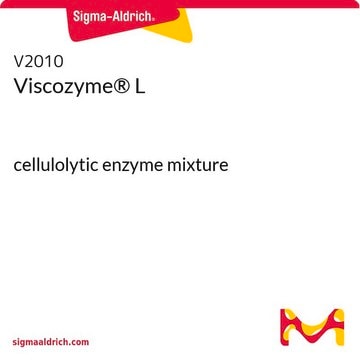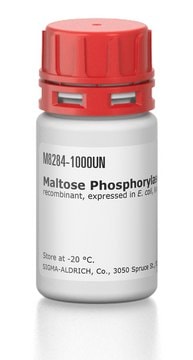This product is provided as a slurry containing 10 mg of enzyme in saturated ammonium sulfate precipitate. It is supplied at 100 units, with a concentration of 0.13 units per 1 mg of protein at 10 mg per ml.
E6412
Cellobiohydrolase I from Hypocrea jecorina
0.13 U/mg, recombinant, expressed in corn
Sinônimo(s):
Cel7A, Cellobiosidase, Cellulase
About This Item
Produtos recomendados
recombinante
expressed in corn
Formulário
liquid
atividade específica
0.13 U/mg
características do produto alternativo mais ecológico
Design for Energy Efficiency
Learn more about the Principles of Green Chemistry.
sustainability
Greener Alternative Product
categoria alternativa mais ecológica
Condições de expedição
dry ice
temperatura de armazenamento
−20°C
Categorias relacionadas
Descrição geral
Aplicação
Ações bioquímicas/fisiológicas
Definição da unidade
forma física
Palavra indicadora
Danger
Frases de perigo
Declarações de precaução
Classificações de perigo
Resp. Sens. 1
Código de classe de armazenamento
10 - Combustible liquids
Classe de risco de água (WGK)
WGK 3
Ponto de fulgor (°F)
Not applicable
Ponto de fulgor (°C)
Not applicable
Escolha uma das versões mais recentes:
Certificados de análise (COA)
Não está vendo a versão correta?
Se precisar de uma versão específica, você pode procurar um certificado específico pelo número do lote ou da remessa.
Já possui este produto?
Encontre a documentação dos produtos que você adquiriu recentemente na biblioteca de documentos.
Os clientes também visualizaram
Artigos
Uncover more about glycosaminoglycans and proteoglycans including the structure of glycosaminoglycans (GAGs), the different types of GAGs, and their functions.
-
Good morning. This material is liquid. Could you tell me the volume that comes in the bottle?
1 answer-
Helpful?
-
Active Filters
Nossa equipe de cientistas tem experiência em todas as áreas de pesquisa, incluindo Life Sciences, ciência de materiais, síntese química, cromatografia, química analítica e muitas outras.
Entre em contato com a assistência técnica











